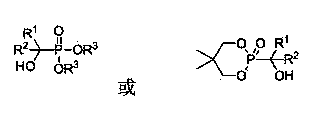Method for solvent-free solid phase catalytic synthesis of hydroxyl phosphonic acid ester
A solvent-free technology for synthesizing hydroxyphosphonates, applied in the field of solvent-free solid-phase catalytic synthesis of hydroxyphosphines and synthesizing hydroxyphosphonates, can solve the problems of easy deliquescence, complicated operation process, difficult synthesis, etc., and avoid the generation of waste water , the effect of simplifying the synthesis process and reducing the cost
- Summary
- Abstract
- Description
- Claims
- Application Information
AI Technical Summary
Problems solved by technology
Method used
Image
Examples
Embodiment 1
[0022] In a 100mL three-necked flask, add furfural (0.96g, 10mmoL), dimethyl phosphite (1.2g, 11mmoL) and potassium carbonate (1.38g, 10mmoL), stir, heat to 30°C to melt furfural, and react for about 60 Minutes, all the reactants solidified. Then 40 mL of ethyl acetate was added, stirred for 20 minutes to dissolve the product, and filtered. The filtrate was concentrated and recrystallized to obtain the product (1.94 g), with a yield of 94%. Recover solvent. Dry the filter cake for later use. 1 HNMR (CDCl 3 , TMS, 400Hz) δ 3.74–3.85 (m, 6H, 2×(O–CH 3 )), 6.38 (d, 1H, J = 13.6Hz), 6.42–6.76(m, 3H, C 4 h 3 O–); HRMS Calcd. for C 7 h 11 o 5 P: 206.0344, found: 207.1061.
Embodiment 2
[0024] In a 100mL three-necked flask, add 2-thiophenecarbaldehyde (1.12g, 10mmoL), diethyl phosphite (1.52g, 11mmoL) and potassium acetate (0.49g, 5mmoL), stir, and heat to 50°C to make 2-thiophene The formaldehyde melted and reacted for about 10 hours, and all the reactants solidified. Then 20 mL of dichloromethane was added, stirred for 20 minutes to dissolve the product, and filtered. The filtrate was concentrated and recrystallized to obtain the product (2.30 g), with a yield of 92%. Recover solvent. Dry the filter cake for later use. 1 HNMR (CDCl 3 , TMS, 400Hz) δ 1.42 (m, 6H, 2×(C–CH 3 )), 3.70–3.81(m, 6H, 2×(O–CH 3 )), 6.51 (d, 1H, J = 13.3Hz), 6.69–7.23 (m, 3H, C 4 h 3 S–); HRMS Calcd. for C 9 h 15 o 4 PS: 250.0429, found: 251.1161.
Embodiment 3
[0026] In a 100mL three-necked flask, add 2-acetylfuran (1.10g, 10mmoL), dibutyl phosphite (1.14g, 11mmoL) and potassium carbonate (0.69g, 5mmoL), stir, and heat to 70°C to make 2-acetylfuran The furan melted and reacted for about 24 hours, and all reactants solidified. Then 40 mL of ethyl acetate was added, stirred for 20 minutes to dissolve the product, and filtered. The filtrate was concentrated and recrystallized to obtain the product (2.86g) with a yield of 94%. Recover solvent. Dry the filter cake for later use. 1 HNMR (CDCl 3 , TMS, 400Hz) δ 1.31 (m, 12H, 4×(C–CH 3 )), 1.5 (m, 2H, 2×(O–CH) ) 1.67 (d, 3H, J = 15.6Hz, CH 3 ), 3.70–3.81 (m, 6H, 2×(O–CH 3 )), 6.47 (d, 1H, J = 13.6Hz), 6.62-7.27 (m, 3H, C 4 h 3 O–); HRMS Calcd. for C 12 h 21 o 5 P: 276.1127, found: 277.2081.
PUM
 Login to View More
Login to View More Abstract
Description
Claims
Application Information
 Login to View More
Login to View More - R&D
- Intellectual Property
- Life Sciences
- Materials
- Tech Scout
- Unparalleled Data Quality
- Higher Quality Content
- 60% Fewer Hallucinations
Browse by: Latest US Patents, China's latest patents, Technical Efficacy Thesaurus, Application Domain, Technology Topic, Popular Technical Reports.
© 2025 PatSnap. All rights reserved.Legal|Privacy policy|Modern Slavery Act Transparency Statement|Sitemap|About US| Contact US: help@patsnap.com

